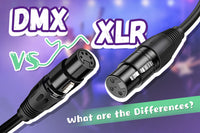The type of audio cables and small changes in the audio setup have a large impact on audio quality. Using an incorrect audio cable may cause noise in your audio system. Audio cables come in balanced and unbalanced types. What’s the difference between balanced and unbalanced audio and how to distinguish these two types of audio? This post will help you know their differences and make the right decision.
What is Unbalanced Audio?
Unbalanced audio is usually carried by an unbalanced cable and connector consisting of two conductors including a signal wire and a ground wire. The signal wire carries and transfers the audio signal, while the ground wire is used to prevent the audio signal from noise and interference during the transmission. However, the signal wire itself can bring some unwanted interference and noise and the ground wire cannot effectively avoid noise. Typically, short-distance transmission will be more suitable for unbalanced audio.
Unbalanced Cable Problems
Unbalanced cables have the risk of outside noise. But where do these interferences come from? Unbalanced audio can be affected by EMI (Electromagnetic Interference) from power cables and other electronic devices. It can also be impacted by RFI (Radio Frequency Interference) from wireless devices and radio transmitters. Some old non-LED stage lighting like spotlights and dimmers can also be culprits of noise. Too much noise can cause signal leakage, so you need to place the unbalanced cables far away from the power cables to minimize the noise.
Unbalanced Cable Types
RCA cable
RCA was created by Radio Corporation of America in the 1930s, aiming to transmit audio signals. RCA comes in female and male types, and RCA cables can support both digital and analog audio formats. An RCA cable is a typical unbalanced audio cable, usually used in pairs or sometimes in triples for audio setups. Therefore, two or three plugs may be equipped on an RCA cable, the white for audio left, the red for audio right, and the yellow for video in the common case. A male RCA plug has a metal tip surrounded by a metal ring that can fit into a corresponding female RCA jack. When inserting the plug into the jack, they have to be pushed fully and make them touched tightly together or it will lead to a buzzing sound. Various types of RCA connectors including RCA connectors for coaxial cables, audio RCA connectors, Right-angle RCA connectors, and straight RCA connectors are available for different requirements.
Although the HDMI cable is always an optimal choice to connect devices for audio and video transmission, the RCA cable has its own application scenarios including watching TV and using speakers and stereos. Besides, RCA cables are low-cost relatively.

1/4-Inch TS Cables
TS cables have a simple construction of tip and sleeve. Tip, serving as the conductor, connects the signal wire to send the audio signal. Sleeve, regarded as the return path of the signal connects to the ground wire to protect the signal from interference. But the resistance to interference is not as good as the balanced cable because there is no inversion signal to cancel interference. The unbalanced design limits its applications in some scenarios.
Besides, with only one conductor, the TS cable is only able to transmit mono and unbalanced audio signals instead of complex audio signals like stereo audio. However, the simple construction also makes it easy to use and maintain at a low cost. TS cables are still a practical choice for a lot of audio devices.
Common connector sizes are 1/4-inch, 1/8-inch (3.5mm), and 1/16-inch (2.5mm), used in different devices. The 1/4-inch TS cable is regarded as a standard size mostly used in musical instruments like electric guitars, bass, and keyboards.
What is Balanced Audio?
A typically balanced audio cable features two signal wires and a ground wire. One signal wire is used to transmit cold (negative) signals and the other is for hot (positive) signals. These two signal wires are reversed in polarity, so they cancel each other when they reach the receiving end. The largest advantage of balanced audio is that it can avoid unwanted interference. Though two signal wires can bring noise, they can cancel out when they reach the end of the cable and achieve synchronization.
How Do Balanced Cables Work?
Balanced cables work by using the opposite signal phase. Phase is a property of an audio signal that describes the position of a waveform in the periodic cycle. Like unbalanced audio cables, the ground wire can withstand parts of electrical interference. But there is still some interference affecting the signal transmission. When the signal reaches the receiving end, the cold signal is inverted back to the in phase with the hot signal, meaning that the identical noise signals are in opposite phases with each other and cancel out. The cold and hot signals are also summed up for a clean signal.

Balanced Cable Types
XLR Cables
XLR cable is a professional audio cable for transmitting balanced audio. It has a circular audio connector with three pins. XLR cable is one of the most common balanced cables, providing a clear audio signal over long-distance transmission. XLR cables are often used for microphones, PA systems, and other professional audio setup.

Quarter-Inch TRS Cables
TRS is composed of three components: tip, ring, and sleeve. Tip refers to a “hot” signal, ring refers to a “cold” signal and sleeve refers to ground wire. It can transmit both mono or stereo (balanced or unbalanced) signals. TRS cables are often used for audio interfaces and musical instruments.
Balanced vs Unbalanced Audio: What is the Difference?
- Length: Unbalanced audio is suitable for short-distance signal transmission (usually 5-10 meters). Unbalanced cables are more prone to pick up noise interference over longer distances. While balanced audio allows the audio cable to run a much longer distance with minimal loss of audio quality.
- CableConstruction: The unbalanced cable only has a signal wire and a ground wire. In contrast, a balanced cable features two signal wires and a ground wire.
- Cost: The unbalanced cable costs less than the balanced cable because of its simple construction and features. Balanced cables can be more expensive because of their interference rejection. In addition, balanced cables should be paired with those sophisticated devices for the best performance.
- Audio Quality: Unbalanced audio usually picks up some noise like hums or buzzes especially in an environment full of electrical devices. On the contrary, balanced audio avoids unwanted noise, ensuring clear and intact audio.
Balanced vs. Unbalanced Audio: Which One Should You Use?
Balanced audio outperforms unbalanced audio in various aspects. Its noise cancellation, interference resistance, long-distance transmission capabilities, and high-quality audio make it a preferred choice in many fields. Balanced cables provide a clear and intact audio signal, which is a go-to option for professional audio setups. For example, if you are looking for an audio cable for professional broadcasting, or high-end audio recording, balanced audio is the best choice. In addition, if you need to use the audio cable across a large stage, balanced cables can ensure the best audio signal without degradation.
So, when can you use unbalanced cables? The low cost of unbalanced cables makes them favored by those lower-budget and short-distance audio setup where the signal distortion is rare. Unbalanced audio is sufficient for daily scenarios where there is minimal electromagnetic interference and noise.
Conclusion
Whether you choose balanced or unbalanced audio, the final goal is to get high-quality audio with minimal signal degradation. It’s true that balanced audio has better features than unbalanced audio, but that doesn’t mean the unbalanced audio is obsolete. The decision should depend on your specific demand for audio setup.
For more information on this topic, you can keep up on our blogs. While VCELINK offers general and basic information for our customers and other visitors to the website, it’s not professional advice.






Be the first one to comment.
Leave a comment